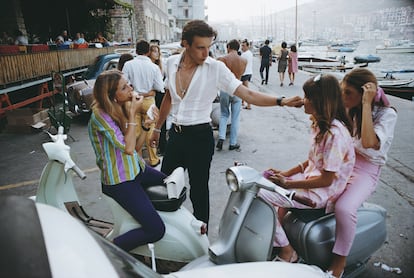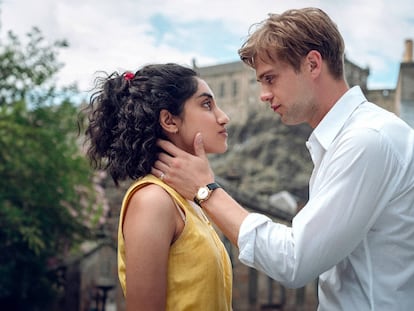‘It’s not like flirting used to be, but it’s close’: A new generation of dating turns its back on Tinder
The hookup app revolution has gotten old. While classic apps work on their reputational crisis, new platforms propose a break with the philosophy of their predecessors


Having met one’s partner online is no longer considered taboo. Long gone are the days when one made giggling confessions about finding love through a chat or an application. The situation is no longer even exotic enough to write songs about it. Cybersecurity firm Kaspersky finds in its report Influencia de la tecnología en la vida de los españoles (Technology’s influence on the lives of Spaniards) that 40% have used or use applications to meet people and that 18.6% met their partner on the internet.
However, more and more users of such platforms are falling victim to the weariness and hopelessness that can emerge in the face of an endless succession of dates. Out of the despair generated by a failure to find love in the digital universe, new formulas are being born that look to embrace the art of IRL meetings. Such is the case of the Pear ring, which costs $34.56 and is worn by single people to advise the world of their marital status. “If all the singles in the world wore this turquoise (or purple, for the LGBTQI community) ring to indicate their status, we wouldn’t need dating apps,” reads its website.
This March saw the inauguration of Closer, whose creators, Arturo Vacas and Martín Zulueta, say is the complete opposite of a hookup app. Here there are no matches nor swipes: chemistry is tested face to face. “You match with someone and feel like there’s chemistry between the two of you. Is it real? Open Closer and answer a random question about him or her. If the interest wasn’t mutual, you’ll never hear from this person again. If it was, Closer will work its magic and you’ll be able to chat,” explain the instructions for what its creators describe as an “anti-app”.
“We don’t consider ourselves a dating app, because you have to have seen someone in the street to be able to talk with them, so it’s not a network you’ll use at home. You’re also not putting all your hope in an application: we’re talking about something that is real and tangible, not just sending a random request,” says Inés Velasco, brand manager. “Some people think that technology is the enemy, but we believe the opposite. My 13-year-old cousins would die of embarrassment if they had to order a pizza by telephone, because they’re not used to having to call. We’d also never approach someone we’re attracted to on the subway. What we’ve done is take a hold of this reality that reflects what’s happening to the newer generations, and try for a more human technology that helps us,” she says.

González, the creative director of Closer, came up with the idea that the project could be the opposite of a more standard dating app. “It’s the most human social network that we were able to create, because it goes back to the romantic idea of meeting someone away from the catalogue of people on the apps and even on Instagram. When people say that the youth can’t do anything without an app, we tell them that Closer is a tool. It’s about facilitating contact. More than technologizing relationships, it’s about humanizing them,” he tells EL PAÍS. A note on those “catalogues of people”: while other apps present infinite filters for searches and ask for endless data with which to present you to the world, Closer only requires your name (which will only appear if the other user accepts you), a photo and sexual orientation.
The weariness of love’s never-ending search
Frustration with online dating has even been acknowledged by the applications themselves, as illustrated by Bumble’s snooze mode, an option that allows one to pause activity on the app while retaining one’s connections and chats. “Your profile can’t be seen by other users for 24 hours, 72 hours, a week or indefinitely. During that time, you can choose a status that shares the reason for your absence with your existing connections, to take a break without losing your chats or connections,” says its website.
“This kind of application forces us to consume people and emotions, without allowing ourselves time to really develop a relationship. Relationships are built, and these apps don’t allow for second chances. In addition, there are people who don’t understand that there is a person behind the screen, and their ways of relating on the apps lacks real emotions beyond immediate pleasure,” says Eva Campos, author of the book Y te doy mi corazón: Manual para identificar banderas rojas y sobrevivir a ellas (And I give you my heart: A manual for identifying red flags and surviving them). “This is the perfect formula for frustration. The pileup of experiences that people can have on this kind of app can often translate into a loss of self-esteem and even depression,” says the writer.
The paradox of face-to-face apps
The application Meetic, designed for shy people who may find dating uncomfortable, came up with the idea of three-minute blind dates, another hybrid formula for finding a partner (or whatever else one is seeking). “Worrying about physical appearance, running out of things to talk about, not getting the feeling for a person … they’re no longer cause for concern, because any bad date will only last for three minutes and then you’ll get another chance to find love. If you both think there was a connection, you can take off the virtual blindfold and continue the date with a face-to-face videocall,” its website says. Creators of the app swear that this is a less stressful strategy than traditional dating. “They’re blind dates and focus on questions to break the ice. Plus, since you’re meeting someone without seeing their profile or photos, there’s greater room for intuition, allowing for a more authentic experience. On the other hand, it’s a more relaxed way to meet people that lets the individuals connect more quickly, which allows them to save time, since we only allow compatible profiles to get in touch with one another,” the site says.

Closer was downloaded 4,000 times during its first 24 hours, a sign that many people may be looking to recover the flirting tactics of yesteryear … But isn’t it a paradox to run from the apps, yet still need an app to make contact? Zulueta, co-founder of Closer, explains that the idea is “to solve a problem for people who don’t dare to speak directly to the person they like. We created an app to make that moment happen. We can’t say that it’s like flirting used to be, but it’s the closest you can get … Plus, it’s not just an ally for people who don’t dare to approach others, but also in those moments in which you really can’t, because you’re with your family or in a meeting, for example. There are a lot of opportunities we miss because we’re embarrassed,” he says.
Jorge Basante, a 22-year-old publicity student, uses Closer. “I was intrigued when I learned it was about first seeing someone in person and then sending them a wink. I wanted to try it. It’s going pretty well. The other day, I was exchanging looks with a guy and a little while later, when I got on the app, I saw that he had sent me a wink, so I responded. I think we’re going to meet up this weekend,” he says.
“I think that those of us from Generation Z are afraid of meeting people because of the traumas of other generations,” says Bruno, another 23-year-old Closer user. “Our emotional availability is low. I think that relying less on getting to know people by their appearance, and opting instead for closeness, can generate less negative thoughts.”
Javier, a 38-year-old manufacturing worker, says he was attracted to Closer because of “how it offers a way to meet new people halfway between the virtual and real worlds. We spend so much time messaging on WhatsApp that we forget to relate to each other in the real world.”

Those who still believe in meeting people without applications, but perhaps still with the use of wifi, may well be attendees of Bored of Dating Apps (BODA). It’s a United Kingdom event series that focuses on what organizer Jessica Hope-Evans calls “more mindful dating”. “Remember the feeling of making eyes at a stranger you like in a bar? The moment that you first start talking? Being able to meet someone face to face in a physical place, and not on an application?” asks the network’s website, which clarifies that its events have little to do with speed dating. They’re simply parties at which everyone is single. “One of the best things about our socials are everyone is on the same page. People who are over hook-up casual culture and the fast and furious dating app are all in the same room.”
Does online dating stigma still exist?
Like Damona Hoffman, writer and dating expert, explains to EL PAÍS, “Tinder offered its users ease of use and it reduced the stigma of online dating being for losers.” But did we really leave that stigma behind? “We see that people still prefer to say that they met someone in real life, not on a platform. With what we’ve managed, you can now say that you met someone in both places,” says Miguel Quevedo, Closer’s art director.
Campos thinks that stigma is generational. “The youngest generations have created a 100% digital environment, which isn’t a problem for them, they’ve normalized meeting someone on social networks like Instagram or TikTok or dating apps. The interesting thing is this kind of app is being used by people over 60, who no longer have any problem in saying that they met someone that way. In contrast, for those of us who had one foot in the analogue world, and who lived through the birth of the internet at a certain age, it’s still a bit tricky, maybe because in a certain moment, meeting through a screen was associated with people with few social skills,” he says.
Sign up for our weekly newsletter to get more English-language news coverage from EL PAÍS USA Edition
Tu suscripción se está usando en otro dispositivo
¿Quieres añadir otro usuario a tu suscripción?
Si continúas leyendo en este dispositivo, no se podrá leer en el otro.
FlechaTu suscripción se está usando en otro dispositivo y solo puedes acceder a EL PAÍS desde un dispositivo a la vez.
Si quieres compartir tu cuenta, cambia tu suscripción a la modalidad Premium, así podrás añadir otro usuario. Cada uno accederá con su propia cuenta de email, lo que os permitirá personalizar vuestra experiencia en EL PAÍS.
¿Tienes una suscripción de empresa? Accede aquí para contratar más cuentas.
En el caso de no saber quién está usando tu cuenta, te recomendamos cambiar tu contraseña aquí.
Si decides continuar compartiendo tu cuenta, este mensaje se mostrará en tu dispositivo y en el de la otra persona que está usando tu cuenta de forma indefinida, afectando a tu experiencia de lectura. Puedes consultar aquí los términos y condiciones de la suscripción digital.
More information
Archived In
Últimas noticias
Most viewed
- Sinaloa Cartel war is taking its toll on Los Chapitos
- Oona Chaplin: ‘I told James Cameron that I was living in a treehouse and starting a permaculture project with a friend’
- Reinhard Genzel, Nobel laureate in physics: ‘One-minute videos will never give you the truth’
- Why the price of coffee has skyrocketed: from Brazilian plantations to specialty coffee houses
- Silver prices are going crazy: This is what’s fueling the rally










































